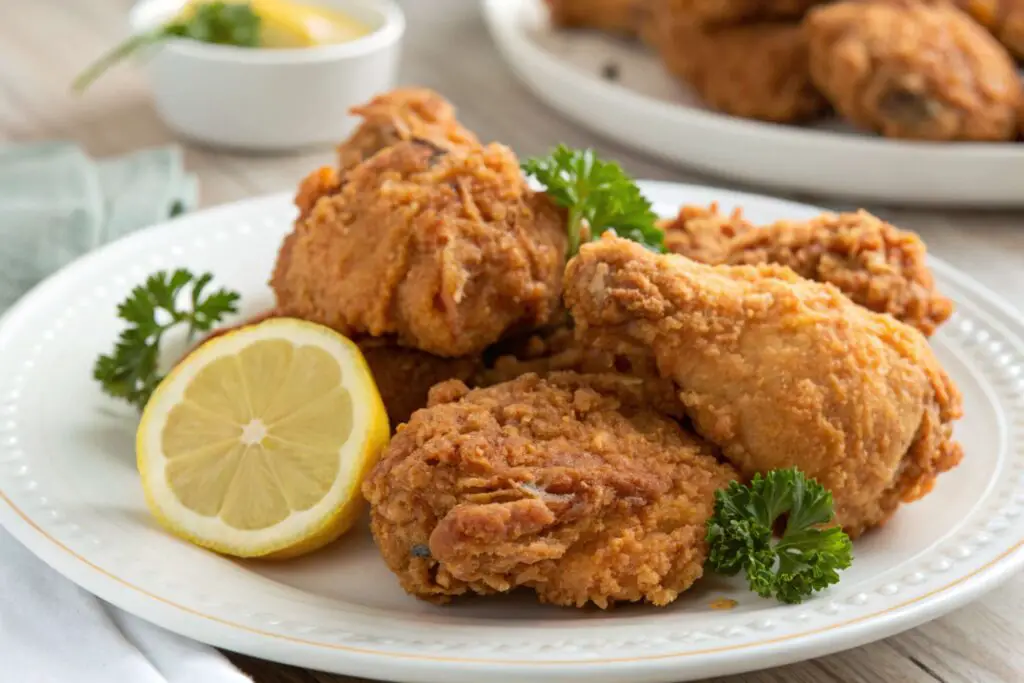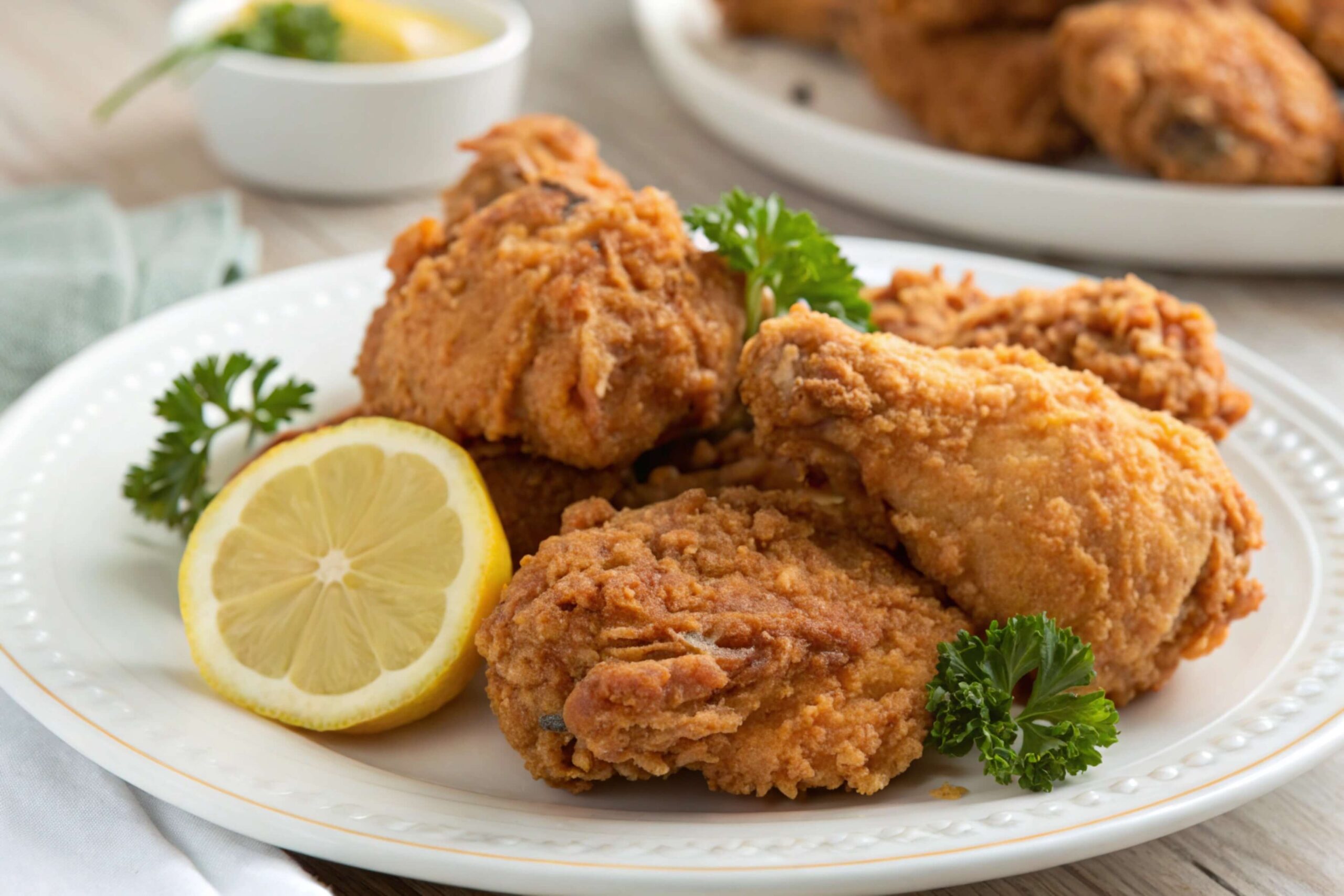want to listen to the recipe ?

There’s something truly special about biting into a piece of perfectly fried chicken. The satisfying crunch of the crust, the tender, juicy meat inside—it’s a culinary experience that I, like many others, find irresistible. My goal here is to share with you everything I’ve learned about making truly amazing crispy fried chicken at home. I’m going to walk you through the techniques, the tips, and the little secrets that will elevate your fried chicken game. We’ll look at two different types of coatings: flour and batter, and how they each contribute to the final result.
Understanding the Keys to Crispy Fried Chicken
What exactly makes fried chicken crispy? It’s not just luck. Several factors work together to achieve that perfect crunch.
- The Maillard Reaction: This is a chemical reaction between amino acids and reducing sugars that happens when you apply heat. It’s responsible for the browning and complex flavors you get when you fry chicken. The Maillard reaction occurs on the surface of the chicken and is key to the development of the crust.
- The Coating: A good coating is crucial for crispiness. A paste-like consistency of the coating is essential. This ensures that the crust is not too thin and adheres well to the chicken. This means that we need to make sure the flour is wet enough before frying.
- Oil Temperature: The oil’s temperature is critical. We’ll start with a high heat to brown the chicken. Then, we’ll reduce the heat to cook the chicken through. Finally, we’ll crank the heat up again to finish the chicken with a super crispy exterior.
- Moisture Control: Excess moisture will prevent a good crust from forming. It is important to ensure that the chicken skin is dry before applying any coating.
Essential Ingredients
Let’s talk about what you will need.
- Chicken:
- I prefer bone-in, skin-on chicken pieces. These give the best flavor and help maintain moisture. Thighs, drumsticks, and wings are great choices.
- You can also use a whole chicken cut into pieces.
- Smaller pieces of chicken ensure that the meat cooks thoroughly without over-browning the crust.
- Breading/Batter Components:
- All-Purpose Flour: This is the base of our coating. It provides the structure for a crispy crust.
- Cornstarch: Adding some cornstarch can make the crust extra crispy. It prevents the crust from getting too tough. It is sometimes used as an alternative to flour.
- Eggs: Eggs will help the flour stick to the chicken.
- Buttermilk or Water: These liquids add moisture and also assist with adhesion.
- Seasonings:
- Paprika: This adds a smoky flavor and helps with browning.
- Salt, pepper, garlic powder, and onion powder: These are the foundations for a tasty fried chicken. You can also add these to the flour in the batter method.
- Other spices: Get creative! Poultry seasoning, cayenne pepper, dried herbs, are all great options.
- “Secret” Spice Blends: Many recipes include a KFC copycat blend. This typically includes many of the spices already mentioned such as garlic powder, pepper and onion powder, but also includes dried thyme, celery salt, and mustard powder.
- Frying Oil:
- Vegetable oil, canola oil, or peanut oil work best for frying. These oils have a high smoke point. These oils have a neutral flavor that will not interfere with the chicken’s taste.
- Other fats can also be used such as lard. These tend to give a different texture to the chicken.
[woo_product_slider id=”3030″]
Step-by-Step Guide to Crispy Fried Chicken
I’m going to cover two main methods of coating: flour coating and batter coating.
Method 1: Flour Coating Method
This is a classic method that delivers amazing results.
- Prepare the Chicken: Cut your chicken into pieces and pat the skin dry with a paper towel. This is important for the coating to stick well.
- Make the Breading: Mix your flour and seasonings in a zip-top bag or shallow dish.
- Dredge the Chicken:
- Dip each piece of chicken into buttermilk until completely soaked.
- Place the soaked chicken in the bag with the flour mixture. Seal and shake well to coat.
- Place the coated chicken on a baking sheet and cover. Let it sit until the flour coating reaches a paste-like consistency. This is a critical step!
- Fry the Chicken:
- Heat your oil to 325-375°F (160-190°C).
- Brown the chicken on both sides in hot oil.
- Reduce the heat and cover the pan. Cook for about 30 minutes.
- Remove the cover and increase the heat again. Fry until extra crispy.
- Drain the chicken on paper towels.
- Use a thermometer to check that the chicken is 165°F (74°C).
Method 2: Batter Method
This method uses a batter to create a crispy crust.
- Prepare the Chicken: Cut the chicken into pieces and pat the skin dry.
- Make the Batter: Combine eggs, water, and some of the flour, salt, and pepper in a shallow dish.
- Prepare the Seasoned Flour Mixture: Combine the remaining flour with garlic salt, paprika, pepper, and poultry seasoning in a separate shallow dish.
- Dredge the Chicken:
- Dip each piece of chicken into the egg mixture.
- Then dip the chicken into the seasoned flour mixture.
- Fry the Chicken:
- Heat the oil to 375°F (190°C).
- Fry the chicken until golden brown and the juices run clear. This typically takes about 7-8 minutes per side.
- Drain the chicken on paper towels.
- Use a thermometer to check that the chicken is 165°F (74°C).
General Frying Tips for Both Methods
- Maintain oil temperature: Use a thermometer to ensure the oil stays at the right temperature.
- Avoid overcrowding: Fry in batches, do not put too much chicken in at once.
- Cook in batches: Do not coat all the chicken and let it sit. It is better to coat the chicken immediately before frying.
- Use a meat thermometer: Check the internal temperature to make sure the chicken is fully cooked.
Advanced Techniques and Variations
Ready to take your fried chicken to the next level?
- Brining and Marinating:
- Buttermilk is a great choice for tenderizing chicken. It can be used for marinating for up to 48 hours, but I would be careful not to marinate for too long, as the chicken can become mushy.
- Other options for marinades include pickle juice, yogurt, or other flavorful liquids.
- Creating an Extra Craggy Crust:
- Double dipping can make the crust thicker and craggier. This method will result in a super crunchy exterior.
- Drizzling some of the marinade into the flour and then rubbing it to create lumps will add extra crunchy bits.
- Spice Variations:
- Don’t be afraid to adjust the spice levels.
- Add hot sauce, cayenne pepper, oregano, or MSG to match your preference.
- Alternative Cooking Methods:
- Oven-baking and air-frying are good for a healthier alternative with a crispy result.
Troubleshooting Common Frying Issues
It’s common to face some challenges when frying chicken. Here are some solutions:
- Why the Crust Isn’t Crispy:
- The oil temperature might be too low.
- The chicken might have too much moisture on it.
- You may not have let the coating reach a paste-like consistency before frying.
- Breading Falling Off:
- The chicken skin may not have been dried properly before applying the coating.
- The breading may not have been pressed firmly enough.
- There may not have been enough coating applied, or the coating was too thin.
- Oily or Greasy Chicken:
- The oil temperature is probably too low.
- The pan might have been overcrowded with chicken.
- Chicken Browning Too Quickly:
- The oil temperature is likely too high.
- Chicken Not Cooking Through:
- The oil temperature is probably too high.
- The chicken pieces are too large.
- Maintaining Consistent Oil Temperature:
- Use a thermometer to monitor the temperature of the oil.
- Adjust the heat to maintain the correct temperature.
Serving Suggestions and Pairings
Fried chicken is great on its own, but sides can make it even better.
- Classic Sides: Mashed potatoes, coleslaw, mac and cheese are always crowd-pleasers.
- Southern-Style Sides: Cornbread, potato salad, and baked beans complete the Southern fried chicken experience.
- Modern and Global Options: You can also serve fried chicken with cream gravy or an array of chicken wing dipping sauces. Try fried chicken with maple syrup as chicken and waffles.
- Creative Pairings: Experiment with different sauces, spices, and toppings. Create a themed meal with other dishes from the same region.
- Other Serving Ideas: Try incorporating the fried chicken into salads, sandwiches, or other creative dishes.
Storage and Reheating
- Store leftover fried chicken in an airtight container in the refrigerator. Make sure you let the chicken cool before covering it, this will help it maintain the crispiness.
- Reheat fried chicken in a 350° oven or an air fryer to restore its crispiness.
Sustainability and Environmental Impact
- Dispose of used oil responsibly. Do not pour it down the drain.
- Look for ways to reduce waste in your fried chicken preparation.
- Be mindful of how your cooking impacts the environment.
Conclusion
Making truly crispy fried chicken is an art that is attainable with the right techniques and ingredients. I hope this guide has given you the tools and knowledge to create amazing fried chicken at home. Don’t be afraid to try different spices, experiment with various techniques, and find the perfect fried chicken recipe for you. The most important thing is to enjoy the process, and the delicious reward.
I hope this is helpful! Let me know if you have any other questions.


